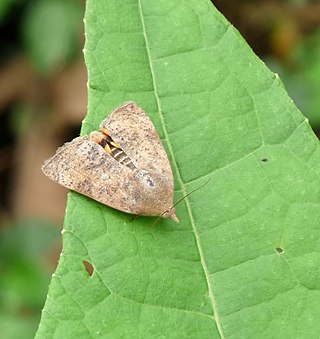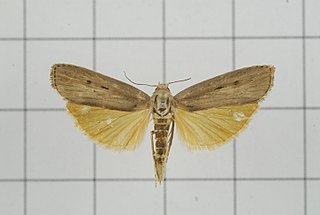
The Crambidae are the grass moth family of lepidopterans. They are variable in appearance, the nominal subfamily Crambinae taking up closely folded postures on grass stems where they are inconspicuous, while other subfamilies include brightly coloured and patterned insects which rest in wing-spread attitudes.

The Pyralidae, commonly called pyralid moths, snout moths or grass moths, are a family of Lepidoptera in the ditrysian superfamily Pyraloidea. In many classifications, the grass moths (Crambidae) are included in the Pyralidae as a subfamily, making the combined group one of the largest families in the Lepidoptera. The latest review by Eugene G. Munroe and Maria Alma Solis retain the Crambidae as a full family of Pyraloidea.

The Pyraloidea are a moth superfamily containing about 16,000 described species worldwide, and probably at least as many more remain to be described. They are generally fairly small moths, and as such, they have been traditionally associated with the paraphyletic Microlepidoptera.

Hyblaeidae are the "teak moths", a family of insects in the Lepidopteran order. The two genera with about 18 species make up one of the two families of the Hyblaeoidea superfamily, which in the past has been included in the Pyraloidea. Recent phylogenetic studies find varying relationships of Hyblaeoidea among Ditrysian Lepidoptera: Mutanen et al. (2010) find the superfamily to group either with Pyraloidea, or – more often – with Thyridoidea or butterflies. The results of Wahlberg et al. (2013) and Heikilä et al. (2015) indicate a sister-group relationship with Pyraloidea.

Spilomelinae is a very species-rich subfamily of the lepidopteran family Crambidae, the crambid snout moths. With 4,135 described species in 344 genera worldwide, it is the most speciose group among pyraloids.
In biological taxonomy, circumscription is the content of a taxon, that is, the delimitation of which subordinate taxa are parts of that taxon. If we determine that species X, Y, and Z belong in Genus A, and species T, U, V, and W belong in Genus B, those are our circumscriptions of those two genera. Another systematist might determine that T, U, V, W, X, Y, and Z all belong in genus A. Agreement on circumscriptions is not governed by the Codes of Zoological or Botanical Nomenclature, and must be reached by scientific consensus.

Udea is a genus of snout moths in the subfamily Spilomelinae of the family Crambidae. The genus was erected by Achille Guenée in 1845. The currently known 215 species are present on all continents except Antarctica. About 41 species are native to Hawaii.

Catharia is a monotypic moth genus described by Julius Lederer in 1863. It contains the single species Catharia pyrenaealis described by Philogène Auguste Joseph Duponchel in 1843. It is found in Central Europe.

Pyralis regalis is a species of snout moth. It is found from most of Europe east to Asia, including China, Cambodia, Myanmar, India, Russia, Korea, Japan and Taiwan.

The Phycitinae are a subfamily of snout moths. Even though the Pyralidae subfamilies are all quite diverse, Phycitinae stand out even by standards of their family: with over 600 genera considered valid and more than 4000 species placed here at present, they unite up more than three-quarters of living snout moth diversity. Together with the closely related Epipaschiinae, they are apparently the most advanced lineage of snout moths.
Psorosa dahliella is a species of snout moth. It is found in France, Spain, Portugal, Switzerland, Italy, Slovakia, Hungary, Croatia, Bosnia and Herzegovina, Romania, Bulgaria, North Macedonia, Greece, Ukraine and Russia.

Phycitodes albatella is a species of snout moth. It is found in most of Europe, Uzbekistan and North America.
Phycitodes inquinatella is a species of snout moth. It is found in most of Europe, the Canary Islands, Turkey and the Palestinian Territories.

Pyrausta virginalis is a species of moth in the family Crambidae. It is found in southern Europe, Turkey, Armenia and Afghanistan.

Platytes cerussella is a species of moth in the family Crambidae. It is found in almost all of Europe.

Tirathaba mundella, the oil palm bunch moth, is a species of snout moth. It is found in Malaysia.

Glaphyriinae is a subfamily of the lepidopteran family Crambidae. It was described by William Trowbridge Merrifield Forbes in 1923. The subfamily currently comprises 509 species in 75 genera.

Scopariinae is a subfamily of the lepidopteran family Crambidae. The subfamily was described by Achille Guenée in 1854.
Zebronia phenice is a moth in the family Crambidae. It was described by Stoll in 1782. It is found in Cameroon, Mayotte, the Democratic Republic of Congo, Equatorial Guinea, Ethiopia, Gabon, Ghana, Ivory Coast, Kenya, La Réunion, Madagascar, Mauritius, Mozambique, Nigeria, Senegal, Sierra Leone, South Africa, Tanzania, Gambia, Uganda, Zambia and Zimbabwe.

Lineodini is a tribe of the species-rich subfamily Spilomelinae in the snout moth family Crambidae.













